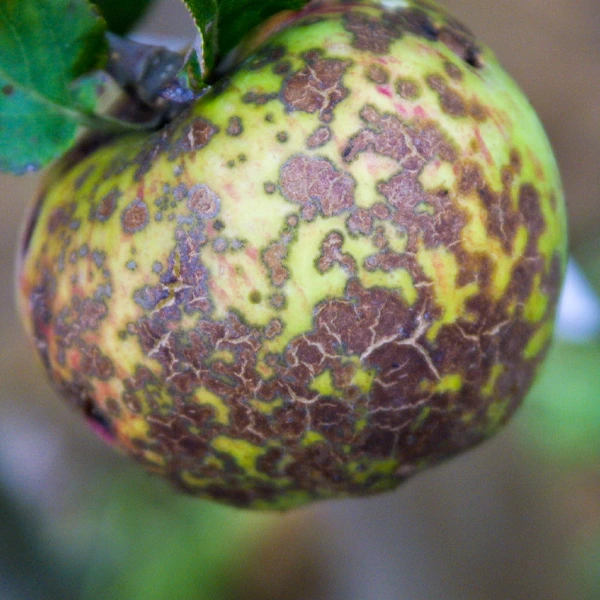Table of Contents
What is Apple Scab and Pear Scab?
Apple Scab and Pear Scab are functionally the same, although the specific fungus is different:
- Apple Scab is the fungus Venturia inaequalis, which infects both orchard apples and crab apples, as well as Cotoneaster, Pyracantha and Sorbus species.
- Pear Scab is the very closely related fungus Venturia pyrina, which infects both orchard pears and ornamentals varieties like weeping pears.
Can I eat apples and pears with Scab?
Yes, apples and pears with scab are perfectly safe to eat. They only look ugly, underneath the skin they should taste the same, unless they are also rotten!
- They won’t store, so you’ll need to juice varieties that are normally ripened off the branch.
- Home cider makers generally don’t bother removing scabby skin, they just use campden tablets to sterilise the brew.
Apple Scab & Pear Scab Symptoms
Scab attacks almost all parts of the tree: new stems, foliage, flowers, and fruit.
It stunts and distorts leaf growth, and can clearly be seen as brown patches of dead tissue on apple leaves, or black patches on pear foliage.
Leaves with scab turn yellow and fall earlier than usual. If the attack is severe, it can defoliate the tree.
Fruit tends to be undersized and scabby all over; as it grows, these scabs harden and often crack.

Apple Scab & Pear Scab Causes
- Relatively warm Autumns and Winters cause leaves to fall later, and emerge earlier than usual.
- This gives the fallen leaves less time to decompose before the vulnerable new leaves appear, so over wintering scab spores (among other pests & diseases) are more of a problem.
- In the spring, scab spores settle on the tree, regenerate, release more spores in late March to early April, then do it again at intervals of a few weeks.
- This makes the disease appear to be progressive, but it is actually caused by waves of infection.
Scab is more common in warmer, humid parts of the UK, mostly in the South and West.
You should not be put off growing apples and pears in those areas, as choosing the right varieties and good hygiene make a huge difference, before you even reach for a fungicide.
Apple Scab & Pear Scab Prevention
As is so often the case in gardening, hygiene is crucially important.
- Raking up and burning all Autumn leaves in the orchard will bring a significant reduction in infection the following Spring, for scab as well as other fungal and insect pests.
- Pruning and burning infected young shoots, which will have cracked, coarse bark in Winter, also removes overwintering spores.
- Well planted and watered trees, mulched with wood chips or other organic matter in Spring, are stronger and more resistant.
- Before bud burst, mow the orchard, which helps to break down remaining leaves from the previous year, and disturbs the fungus before it is ready to spread.
- Plant your orchard in a poly-culture where, at the very least, no two trees of the same cultivar are next to each other.
- Better yet, plant a sequence like apple – cherry – pear – plum, thus keeping the species separated. This prevents any disease or pest from having a wall-to-wall banquet.
- For bonus points, add a few nitrogen fixing trees like Red Alder, Alnus rubra (which produces fewer suckers than other alders, making it easier to manage) and coppice them for firewood.
Scab Resistant Apple and Pear Varieties
One of the best eating apples for scab prone areas is Red Windsor.
- Scab resistant eating apples include:
- Scab resistant cooking apples include:
Beurre Hardy is the most scab resistant pear.
Scab Chemical Treatment
At the time of writing, there are no seriously effective, legal chemical controls for the home grower.
The nearest things to an organic fungicide against scab are copper based: sulphur is less efficient, and some “sulphur shy” varieties really don’t like it.
Follow the manufacturer’s instructions. Generally, the first spray should take place when the buds are closed, and the second when they are barely beginning to show the first signs of colour as they open. Spray when the air is still, in the evening when there are fewer pollinating insects around.
